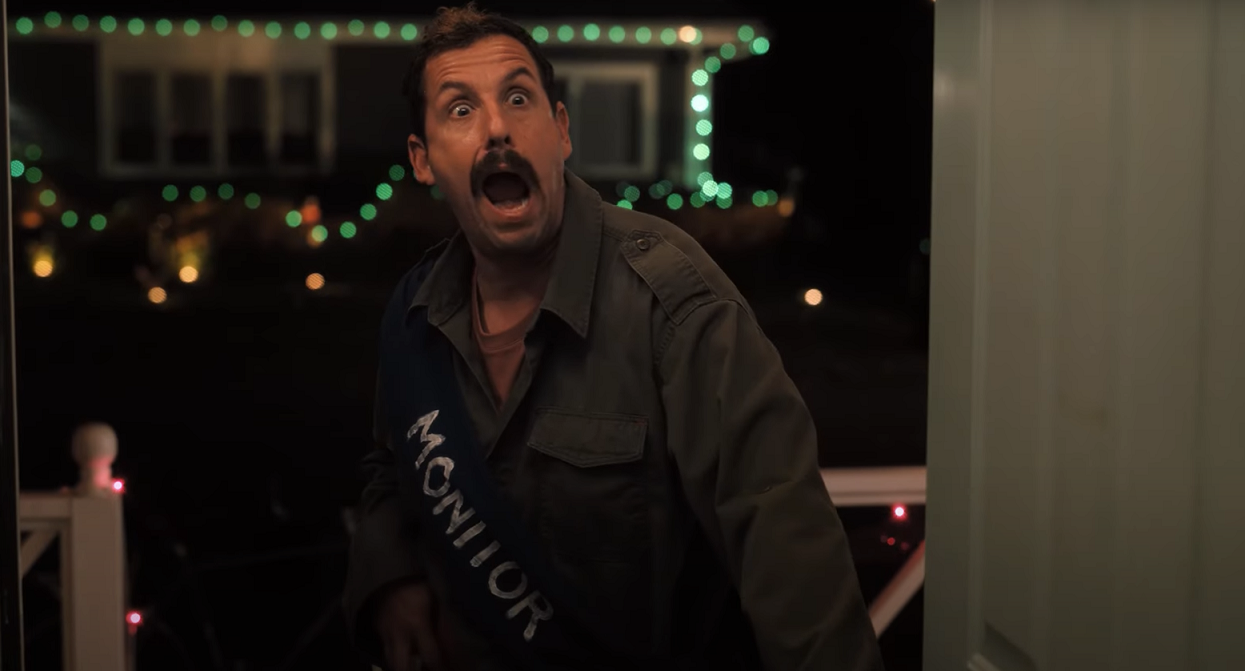
Hubie Halloween is a good time, offering up more treats than tricks and adding a new film to the non-horror Halloween canon.
Hubie Halloween tells the story of Hubie DuBois, a simple man from Salem, Massachusetts, as he endeavors to protect the citizens of the town on the titular holiday. The film sets Hubie up as a character who suffers from some sort of learning disability, however the most important aspect of his character is his kindness, which becomes the real source of joy when watching this movie. Hubie Halloween is the kind of film that one could expect from Happy Madison Productions. It follows a similar formula to the other films produced by Happy Madison such as Happy Gilmore, Billy Madison, and The Waterboy; save for one key aspect of the film, which is that Adam Sandler’s protagonist is the most likeable character in the film. Hubie Halloween is the endorsement of kindness and empathy that 2020 needs, and that is what makes the film worth watching. The film is dotted with some stellar laugh out loud moments (just as many failed to get a reaction), but the heartwarming nature of the story carried this film across the finishing line.
Sandler’s Hubie is warm, endearing, and lovable. At times he feels like a cartoonish, slapstick punching bag for the film, but this really helps the audience sympathize with him. Besides Sandler, the film features a talented cast of frequent Sandler collaborators, such as Steve Buscemi, Rob Schneider, and Kevin James . Their characters are ephemeral and Altmanesque, wandering in and out of the movie in a way that would put you in mind of Cookie’s Fortune. That being said, the film’s director Steven Brill is no Robert Altman. Whereas Altman’s films use large casts to create a sense of atmosphere, this film really feels like people are just there for the sake of being there. Still the cast adds to the enjoyment. One of the comedic high points of the film is the Shaquille O’Neal cameo that feels inspired by John Carpenter’s The Fog. Special attention must also be given to June Squibb, whose character with her many thrifted t-shirts prompt some of the film’s best gags. However, one performance that I was not in love with was Julie Bowens. She plays the love interest who is able to look past Hubie’s apparent disabilities and appreciate him for who he is and see him as an incredibly kind man. As the movie goes on, she gets a little too zany, thus reducing her character from a kind woman who is able to see past the surface level awkwardness of Hubie into an equally unique and bizarre character. If Steven Brill had her play it down more, the film would have felt a little more consistent and genuine.
That being said, I do want to give recognition to Steven Brill’s ability to swing from funny to sentimental without it seeming tonally all over the place. The cinematography complimented the film wonderfully; the daytime scenes portray the landscape of Salem as a dreamy Maxfield Parrish-esque town, although the night scenes were nothing special. Seamus Tierney, the film’s cinematographer, had a really inspired look for large parts of the film. It is disappointing that when the sun set, the film lost its unique picturesque style photography.
Another standout element of the film is its soundtrack. A charming and seasonal compilation featuring standouts such as the theme to Ghostbusters by Ray Parker Jr., to Werewolves of London by the all-time great Warren Zevon. Perhaps most importantly, the film features The Monster Mash by Bobby Pickett early on, which really sets the tone for the movie. This truly shows the benefit of this being an Adam Sandler & Netflix film. With less money, the film would not have been able to afford as much great music, and it would have been worse off without it.
Taking off the rose colored glasses, the movie is not without its flaws. The biggest sin this movie commits seems to be the collective sin of all movies that I have seen in the past few years: they are just too long. This film is 103 minutes and anywhere from 15-25 minutes too long. Also of those 103 minutes, 15 minutes were credits. So the movie was really only an hour and a half, but it still felt too long. The two culprits for this bloated runtime are the overused gags and the way in which the cast pops in and out of the movie. I think filmmakers are afraid of making movies that are shorter than an hour and a half, largely due to ticket prices, but Hubie Halloween could have avoided this altogether. As a Netflix original, it benefits from being shorter than the competition, as it does not need to justify a ten dollar ticket. The movie could pair itself down just by cutting some of its redundant and repeated gags—watching Hubie fly face over handlebars is only funny so many times.. There were also some characters who were only there to create mystery, and in the end I am not sure it was worth it.
On a final note, you probably can’t just plop down in a chair, go to Netflix, and truly enjoy Hubie Halloween as much as I did, considering how anxiously I awaited this release. Before I began the movie, I even went to CVS and purchased some Halloween candy. In fact, I can’t think of a better analogy for Hubie Halloween than Halloween candy. If you eat it year round, it will leave you feeling sick and empty, but if you enjoy it in small quantities and only around the holiday, it elevates the festivities and the overall experience.